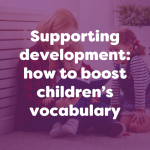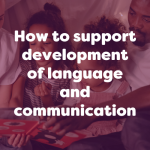This blog has been supplied by EYR’s exclusive partner PACEY – the professional association for childcare and early years. In this blog they share their advice on choosing a childcare provider in the hope of supporting both parents and carers. So read ahead to discover more about the different types of childcare available, key questions to consider and an overview of what to expect.
When the time comes, choosing a childcare provider is probably one of the biggest choices you will have to make. At times it can feel overwhelming, with lots to consider. From cost and location, to the type of learning your children will experience, there are likely to be lots of questions you may have.
There are several different types of childcare to choose from, provided by thousands of different childcare providers in the UK. We’ve pulled together some top tips to give you an overview of the options available; practical considerations; as well as some questions to ask – all to help you make an informed decision.
Types of Childcare
There are two broad types of childcare that most parents can choose from, each with enormous benefits to children. Home-based, or domestic, childcare includes childminders and nannies. Group-based, or non-domestic, childcare refers to settings outside of a home such as a nursery or a pre-school.
Domestic childcare can refer to any of the following:
- A registered childminder is self-employed and works in their own home caring for other people’s children. They care for small numbers of children, all year round. They will often care for a range of ages – from babies through to school children.
- Childcare on domestic premises is where four or more people work together from a domestic setting. This could be, for example, four childminders, or two childminders and two assistants.
- A nanny is employed to look after children in your own home. They care for the children within your household, usually siblings. They tend to look after all aspects of caring for your child. Including household chores such as laundry and food preparation.
Non-domestic childcare often refers to any of the below:
- A day nursery looks after children from 3 months to 5 years and they tend to operate Monday to Friday from 8.00am to 6.00pm, but some have extended or alternative hours. They are generally open all year round.
- A pre-school provides sessions for children between the ages of 2 and 5. Most offer either three-hour morning or afternoon sessions, and run term-time only, these are often in public spaces, such as community halls.
- A school nursery is attached to a school and usually accepts children from the age of 3. Nursery classes operate during school hours, term time only, with a session in the morning and a session in the afternoon.
Choosing a Childcare Provider
There is no right or wrong answer when choosing a childcare provider for your children, the choice is your own and there are lots of personal factors that can affect your decision. The best way to approach making your initial decision is to research and ask lots of questions.
A great starting point is carrying out background checks. The law in England states that all childcare providers must be registered with Ofsted to be able to practice. (With the exception of nannies, who may voluntarily register with Ofsted). By reading a setting’s latest inspection report you can easily get a good overview of what a setting will be able to offer your family.
Don’t be afraid to communicate with settings. An email, social media message or phone call is a great way to make first contact and ask initial questions. Many settings will also allow you to visit to get a feel for the environment. You will be able to ask lots of questions in person as well as meeting the staff members beforehand.
Drawing up a shortlist of questions that are most important to you can help you feel prepared when visiting as well as allowing the practitioner to respond directly to anything you may not fully understand or have anxiety around. Some common questions we have encountered include:
- What is the cost of care?
- What is included in fees and what isn’t (e.g. are there extra costs for food, nappies, wipes etc)?
- What experience / qualifications do staff have and what training is undertaken?
- What is the typical daytime routine?
- How is a child’s progress recorded and how is information shared with parents?
- How is a child’s learning and development supported?
Costs of Childcare
It is worth noting that the Government provides varying levels of funding to help carers of children aged 2 and above. Make sure you’re not missing out on any additional help. For more information you can visit Childcare Choices here.
What should be offered at a childcare setting?
Depending on the type of childcare you choose, there are a number of requirements that must be provided to children. Early years childcare providers in England are Ofsted regulated and perfectly placed to support the early learning and development for children of all ages, working closely with parents to provide bespoke childcare.
Registered childminders in England must follow the curriculum that is laid out in the Early Years Foundation Stage (EYFS). This is published by the Department for Education. In Wales childminders must register with Care Inspectorate Wales (CIW) and follow the National Minimum Standards for Regulated Childcare. All childminders must also hold Public Liability Insurance.
There is no such thing as a ‘typical day’ with a childminder. Your child will learn and develop in a small setting meaning that they are better equipped with their individual needs. Activities could range from craft days to storytelling, with practitioners monitoring the development of the children in their care.
Whilst also offering the same level of early years education, nurseries must offer each child a key person to help ensure that every child’s learning and care is tailored to meet their individual needs. They will spend most time with the child and will be the first point of contact for the child’s parents. For childminder settings the childminder themselves is the key person.




